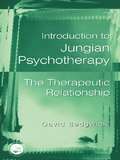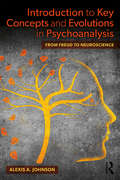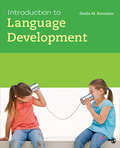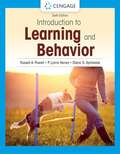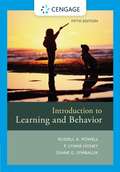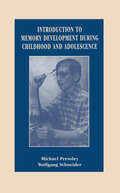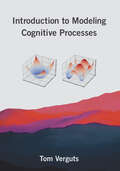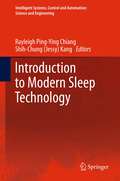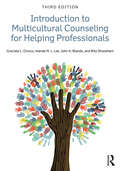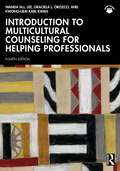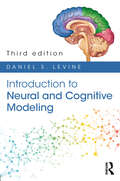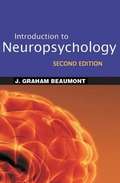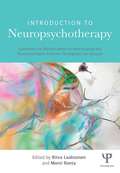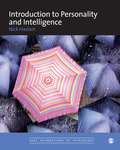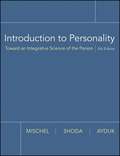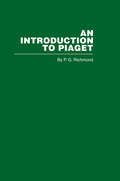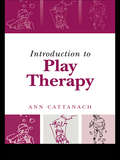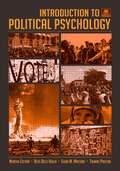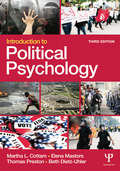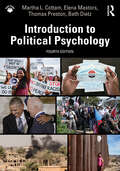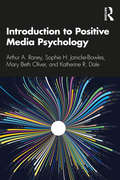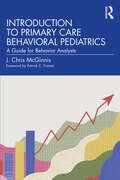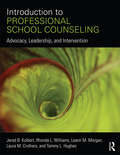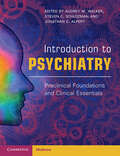- Table View
- List View
Introduction to Jungian Psychotherapy: The Therapeutic Relationship
by David SedgwickThe unique relationship between patient and therapist is the main healing factor in psychotherapy. This book explains the Jungian approach to the therapeutic relationship and the treatment process. David Sedgwick outlines a modern Jungian approach to psychotherapy. He introduces, considers and criticizes key aspects of Jungian and other theoretical perspectives, synthesizing approaches and ideas from across the therapeutic spectrum. Written in an accessible style and illustrated with numerous examples, this mediation on therapy and the therapeutic relationship will be invaluable to students and practitioners of both Jungian and non-Jungian therapy.
Introduction to Key Concepts and Evolutions in Psychoanalysis: From Freud to Neuroscience
by Alexis A. JohnsonIntroduction to Key Concepts and Evolutions in Psychoanalysis offers an accessible starting point to understanding psychoanalysis by focusing on seven key psychoanalytic models and their creators and how the field has evolved over time from Sigmund Freud’s original ideas. The book is based on the premise that Freud started a conversation over 100 years ago that continues to this day: who are we, why do we suffer so, and how can others help? Alexis A. Johnson seeks to make the invariably complex and sometimes contradictory terms and concepts of psychoanalysis more accessible for those being introduced to psychoanalysis for the first time, integrating them into a cohesive narrative, whilst using a broadly developmental perspective. Each model is given space and context, matched with relevant case studies drawn from the author’s own clinical practice. Written in an approachable, jargon-free style, this book brings to life the creators of the models using case studies to illustrate the ‘healing maps’ and models they have developed. The author methodically adds layer upon layer of increasingly challenging insights: Which model is useful or appropriate, and when and how exactly is it useful as part of the healing paradigm? Rather than aligning with any one model, Johnson makes the case that drawing upon aspects of all of these sometimes-competing ideas at various times is important and healthy. Introduction to Key Concepts and Evolutions in Psychoanalysis will appeal to undergraduate students of psychology encountering psychoanalysis for the first time, as well as trainees in psychoanalysis and those working across other branches of the mental health profession wishing to understand and drawn upon fundamental psychoanalytic ideas.
Introduction to Language Development
by Dr Shelia M. KennisonThere are between 4,000 and 6,000 languages remaining in the world and the characteristics of these languages vary widely. How could an infant born today master any language in the world, regardless of the language’s characteristics? Shelia M. Kennison answers this question through a comprehensive introduction to language development, taking a unique perspective that spans the period before birth through old age. Introduction to Language Development offers in-depth discussions on key topics, including: the biological basis of language, perceptual development, grammatical development, development of lexical knowledge, social aspects of language, bilingualism, the effect of language on thought, cognitive processing in language production and comprehension, language-related delays and disorders, and language late in life.
Introduction to Learning and Behavior
by Russell A. Powell P. Lynne Honey Diane G. SymbalukGain a clear understanding of the basic principles of learning and behavior and how you can apply this information to better understand and improve today's world with Powell, Honey, and Symbaluk's INTRODUCTION TO LEARNING AND BEHAVIOR, 6E. This engaging, student-friendly behavioral approach to psychology uses examples derived from both animals and humans to vividly illustrate the relevance of behavioral principles in comprehending and impacting human behavior. Updated, expanded coverage and a dedicated appendix address self-control and behavior self-management in detail with specific tactics you can immediately apply. "Study Tip" guide you in strategies, from effectively reading texts to using procedures to increase concentration and reduce procrastination. You also see how principles apply to managing relationships and raising children. Numerous innovative and updated review, self-testing, learning and independent study features further your understanding of key concepts.
Introduction to Learning and Behavior
by Russell Powell P. Honey Diane Symbaluk Michele SordiINTRODUCTION TO LEARNING AND BEHAVIOR, 5th Edition provides you with a clear introduction to the basic principles of behavior presented in an accessible, engaging manner. Using examples derived from both animals and humans, the text vividly illustrates the relevance of behavioral principles to understanding and improving human behavior. The authors demonstrate the application of behavioral principles to such relevant issues as improving your study behavior, reducing procrastination, raising children, and managing relationships. To help you maximize your learning, the text is packed with innovative study and review tools to further your understanding of key concepts.
Introduction to Memory Development During Childhood and Adolescence
by Michael Pressley Wolfgang SchneiderMemory development has been a central topic in developmental psychology for the past 30 years. This volume summarizes the research achievements during that era and relates those achievements to work on memory development conducted throughout the 20th century. An abridgement of Schneider and Pressley's previous work (Memory Development Between Two and Twenty, Second Edition, 1997, Lawrence Erlbaum Associates, Inc.), this book has been reorganized to better discuss the most important themes in memory development for the novice student. By highlighting the issues driving contemporary memory development research, it provides the knowledge that students require to effectively understand the newest studies on memory development. This textbook is not a history; rather, it offers a framework for understanding the many memory development studies now appearing in the literature. A comprehensive, yet succinct, summary of theory and research on memory development, this volume covers more than a century of research, including European, Soviet, and American contributions. Its organization in terms of basic memory capacities, knowledge, strategies, and metamemory reflects the way that the most important researchers in memory development have conceived of the field during the past two decades. At the same time, it emphasizes the perspective that memory development is not development of any of the components alone, but rather is due to developments in capacity, knowledge, strategies, and metamemory in interaction. As such, the book is appropriate for courses in child development, cognitive development, and cognition and memory--that is, wherever students have a need to know about how leading scholars view the development of memory and intellect.
Introduction to Modeling Cognitive Processes
by Tom VergutsAn introduction to computational modeling for cognitive neuroscientists, covering both foundational work and recent developments. Cognitive neuroscientists need sophisticated conceptual tools to make sense of their field&’s proliferation of novel theories, methods, and data. Computational modeling is such a tool, enabling researchers to turn theories into precise formulations. This book offers a mathematically gentle and theoretically unified introduction to modeling cognitive processes. Theoretical exercises of varying degrees of difficulty throughout help readers develop their modeling skills. After a general introduction to cognitive modeling and optimization, the book covers models of decision making; supervised learning algorithms, including Hebbian learning, delta rule, and backpropagation; the statistical model analysis methods of model parameter estimation and model evaluation; the three recent cognitive modeling approaches of reinforcement learning, unsupervised learning, and Bayesian models; and models of social interaction. All mathematical concepts are introduced gradually, with no background in advanced topics required. Hints and solutions for exercises and a glossary follow the main text. All code in the book is Python, with the Spyder editor in the Anaconda environment. A GitHub repository with Python files enables readers to access the computer code used and start programming themselves. The book is suitable as an introduction to modeling cognitive processes for students across a range of disciplines and as a reference for researchers interested in a broad overview.
Introduction to Modern Sleep Technology
by Shih-Chun Kang Rayleigh Ping-Ying ChiangSleep medicine has been developing for more than 40 years. The current concepts in sleep technology are mainly centered on polysomnography (PSG) and issues related to sleep technicians. However, the editors believe that the true value of technology is revealed only when benefits to humanity are manifest. To this end, they endeavor to create a new era in sleep technology, one that will improve the quality of people's sleep and daily lives.This edited book, Introduction to Modern Sleep Technology, provides a comprehensive reference volume to the latest advancements in the area of Sleep Technology. It offers an excellent range of insights and opinions from leading researchers and experts in multiple disciplines spanning academia, clinical practice and industry. Up-to-date insights into the current research topics in this field are featured in addition to the latest technological advances with reference to appropriate working examples.The current book combines the five dimensions of knowledge, i.e., sleep medicine, clinical psychology engineering, industrial design and technology management to ensure the content is applicable to people's daily lives. This edited book, Introduction to Modern Sleep Technology, provides a comprehensive reference volume to the latest advancements in the area of Sleep Technology. It offers an excellent range of insights and opinions from leading researchers and experts in multiple disciplines spanning academia, clinical practice and industry. Up-to-date insights into the current research topics in this field are featured in addition to the latest technological advances with reference to appropriate working examples.The current book combines the five dimensions of knowledge, i.e., sleep medicine, clinical psychology engineering, industrial design and technology management to ensure the content is applicable to people's daily lives. The current book combines the five dimensions of knowledge, i.e., sleep medicine, clinical psychology engineering, industrial design and technology management to ensure the content is applicable to people's daily lives.
Introduction to Multicultural Counseling for Helping Professionals
by Bita Shooshani Graciela L. Orozco Wanda M. Lee John A. BlandoIntroduction to Multicultural Counseling for Helping Professionals is the essential introductory text in the area of multicultural counseling. Providing a broad survey of counseling techniques for different ethnic, religious and social groups, it is at once thorough and easily understood. Beyond its topic-specific sections, Introduction to Multicultural Counseling for Helping Professionals also includes chapters on the theory and history of multicultural counseling, expanded cultural resources, and an appendix explaining its interrelationship with CACREP accreditation requirements. Now in its third edition, Introduction to Multicultural Counseling for Helping Professionals is updated and revised to reflect the changing landscape of the 21st century. It contains updated statistics on fluid demographics in the U.S., a stronger social-justice perspective throughout the text, and a new chapter on counseling undocumented immigrants. The text is supplemented with online materials, including updated PowerPoint slides with discussion questions and classroom activities, a testbank with new questions for each chapter, and a sample course syllabus, each of which is presented in an updated, more attractive layout.
Introduction to Multicultural Counseling for Helping Professionals
by Graciela L. Orozco Wanda M.L. Lee Kwong-Liem Karl KwanIntroduction to Multicultural Counseling for Helping Professionals, 4th edition, is the essential introductory text for studying multicultural counseling. Providing a broad survey of counseling concepts and techniques for different marginalized ethnic and cultural groups, it is at once practical and easily understood. Beyond its culture-specific sections, Introduction to Multicultural Counseling for Helping Professionals also includes chapters on a basic framework and generic concepts in multicultural counseling. Chapters include case study vignettes, exercises, and thought questions, highlighted brief topics of special interest, and additional cultural resources.The fourth edition has been updated and revised to reflect an inclusive ecological framework and social justice context for counseling. It offers a broad perspective on multicultural counseling theory, including thought from other disciplines, reflections on race and Whiteness in counseling, and new contributions from diverse cultural voices. The text is supplemented with online materials, including PowerPoint slides with suggested discussion questions and classroom activities, a test bank of relevant items, and a sample course syllabus.
Introduction to Neural and Cognitive Modeling: 3rd Edition
by Daniel S. LevineThis textbook provides a general introduction to the field of neural networks. Thoroughly revised and updated from the previous editions of 1991 and 2000, the current edition concentrates on networks for modeling brain processes involved in cognitive and behavioral functions. Part one explores the philosophy of modeling and the field’s history starting from the mid-1940s, and then discusses past models of associative learning and of short-term memory that provide building blocks for more complex recent models. Part two of the book reviews recent experimental findings in cognitive neuroscience and discusses models of conditioning, categorization, category learning, vision, visual attention, sequence learning, behavioral control, decision making, reasoning, and creativity. The book presents these models both as abstract ideas and through examples and concrete data for specific brain regions. The book includes two appendices to help ground the reader: one reviewing the mathematics used in network modeling, and a second reviewing basic neuroscience at both the neuron and brain region level. The book also includes equations, practice exercises, and thought experiments.
Introduction to Neural and Cognitive Modeling: 3rd Edition
by Daniel S. LevineThis textbook provides a general introduction to the field of neural networks. Thoroughly revised and updated from the previous editions of 1991 and 2000, the current edition concentrates on networks for modeling brain processes involved in cognitive and behavioral functions. Part one explores the philosophy of modeling and the field’s history starting from the mid-1940s, and then discusses past models of associative learning and of short-term memory that provide building blocks for more complex recent models. Part two of the book reviews recent experimental findings in cognitive neuroscience and discusses models of conditioning, categorization, category learning, vision, visual attention, sequence learning, behavioral control, decision making, reasoning, and creativity. The book presents these models both as abstract ideas and through examples and concrete data for specific brain regions. The book includes two appendices to help ground the reader: one reviewing the mathematics used in network modeling, and a second reviewing basic neuroscience at both the neuron and brain region level. The book also includes equations, practice exercises, and thought experiments.
Introduction to Neuropsychology, Second Edition
by Andrew Mayes J. Graham BeaumontThis outstanding text gives students a solid grounding in clinical and experimental neuropsychology. The author is a leading authority whose engaging writing style and thorough yet concise coverage of brain localization, anatomy, and their links to cognitive function make the book ideal for undergraduate or graduate use. It is illustrated with more than 60 figures, including six color plates. New to This Edition Incorporates more than two decades of major advances in the field--including developments in basic science, assessment, rehabilitation, and clinical research. Coverage of neuroimaging. Chapter on degenerative diseases and profound brain injury.
Introduction to Neuropsychotherapy: Guidelines for Rehabilitation of Neurological and Neuropsychiatric Patients Throughout the Lifespan
by Ritva Laaksonen Mervi RantaThis groundbreaking volume provides a theoretical overview and clinical guidelines for the application of neuropsychotherapy. It takes a multidisciplinary approach, combining neuropsychological knowledge with recent conceptualizations from neuroscience and psychotherapy, with special emphasis on the role of working alliance. The first part of the book focuses on the historical roots of neuropsychotherapy. Then, a framework of interpersonal process in neuropsychotherapy and conceptualization for clinical purposes are described. Resistance is described through a historical perspective of conceptualizations to the present-day demands of understanding this phenomenon in the process of neuropsychotherapy. In addition, the neuropsychology of emotions is presented in a therapeutic process through a case intervention. The latter chapters of the book are concerned with special interest interventions and psychotherapeutic working methods suited for neuropsychotherapy. Representing a wide variety of theoretical, research oriented, clinical neuropsychological and psychotherapeutic expertise, this book will interest professionals in neuropsychological rehabilitation and those working with patients with cognitive, emotional and behavioral disorders in in-patient and out-patient settings.
Introduction to Personality and Intelligence
by Nick Haslam`The inclusion of the chapter on psychobiography and life narratives is also an innovative inclusion, as this chapter encourages readers to integrate all the previous material into their analysis of famous people, a technique that will without a doubt have students captivated. . . an excellent introductory text' - Australian Journal of Educational and Developmental Psychology `There is a wonderful balance and clarity in coverage of complex and contentious issues. Throughout, the tone is amiable…the writing engaging and clear" - Dr Robbie Sutton, University of Kent Nick Haslam's highly-anticipated new text is a thoroughly engaging introduction to the psychology of personality and, crucially, intelligence. Fully tailored to the British Psychological Society's guidelines regarding the teaching of individual differences, Introduction to Personality and Intelligence provides the perfect package for any first or second year undergraduate psychology student taking a course in this fascinating subject. Key features: - coverage of all core topics for a personality course - a whole section devoted to intelligence - includes mental disorders and cognitive approaches - focuses on major theoretical issues - presents a good range of applied theory chapters - packed with pedagogical features including: key concept boxes and a full glossary, illustrative case studies, and annotated further reading The author's writing style, use of pedagogy and incorporation of the latest empirical research findings makes Introduction to Personality and Intelligence an essential textbook for all psychology students on a personality or individual differences course. (The author's website can be accessed here)
Introduction to Personality: Toward an Integrative Science of the Person
by Walter Mischel Yuichi Shoda Ozlem AydukReflecting the latest developments, this eighth edition paints a picture of the field as a cumulative, integrative science that builds on its rich past. It provides a much more coherent view of the whole functioning individual in the social world. Throughout the chapters, emphasis is placed on practical applications and personal relevance to everyday life in a clear and compelling way. The book also explores the essential features and contributions from the field's heritage
Introduction to Piaget
by R.G. RichmondFirst published in 2006. Routledge is an imprint of Taylor & Francis, an informa company.
Introduction to Play Therapy
by Ann CattanachPlay therapy is a popular and important intervention for many children with psychological problems and traumatic life experiences. Written by a renowned expert in the field, Introduction to Play Therapy provides a basic grounding in play therapy intervention, answering questions such as:· Who can play therapy help?· What are the best settings for play therapy?· How should you train in play therapy?A variety of models of working with play are explored, and an evaluation of the meaning of childhood is discussed in clear language, illustrated with clinical examples.This book will help adults who communicate with children in any role, be they parents, teachers or therapists.
Introduction to Political Psychology
by Thomas Preston Beth Dietz Martha L. Cottam Elena MastorsThe first comprehensive textbook on political psychology, this user-friendly volume explores the psychological origins of political behavior. Using psychological concepts to explain types of political behavior, the authors introduce a broad range of theories and cases of political activity to illustrate the behavior. The book examines many patterns of political behaviors including leadership, group behavior, voting, race, ethnicity, nationalism, political extremism, terrorism, war, and genocide. Text boxes highlight current and historical events to help students see the connection between the world around them and the concepts they are learning. Examples highlight a variety of research methodologies used in the discipline such as experimentation and content analysis. The "Political Being" is used throughout to remind the reader of the psychological theories and concepts to be explored in each chapter. Introduction to Political Psychology explores some of the most horrific things people do to one another for political purposes, as well as how to prevent and resolve conflict, and how to recover from it. The goal is to help the reader understand the enormous complexity of human behavior and the significant role political psychology can play in improving the human condition.Designed for upper division courses on political psychology or political behavior, this volume also contains material of interest to those in the policymaking community.
Introduction to Political Psychology: 3rd Edition
by Thomas Preston Beth Dietz Martha L. Cottam Elena MastorsThis comprehensive, user-friendly introductory textbook to political psychology explores the psychological origins of political behavior. The authors introduce readers to a broad range of theories, concepts, and case studies of political activity to illustrate that behavior. The book examines many patterns of political behaviors, including leadership, group behavior, voting, media effects, race, ethnicity, nationalism, social movements, terrorism, war, and genocide. It explores some of the most horrific things people do to each other, as well as how to prevent and resolve conflict - and how to recover from it. The book contains numerous features to enhance understanding, including text boxes highlighting current and historical events to help students see the connection between the world around them and the concepts they are learning. Different research methodologies used in the discipline are employed, such as experimentation and content analysis. The third edition of the book has two new chapters, one on the media, and one on social movements. This accessible and engaging introductory textbook is suitable as a primary text on a range of upper-level courses in political psychology, political behavior, and related fields, including policymaking.
Introduction to Political Psychology: 3rd Edition
by Thomas Preston Beth Dietz Martha L. Cottam Elena MastorsIntroduction to Political Psychology explores the many psychological patterns that influence individual political behavior. The authors introduce readers to a broad range of theories, concepts, and case studies of political activity, arguing that individuals are driven or motivated to act in accordance with personality characteristics, values, beliefs, and attachments to groups. The book explains many aspects of political behavior—whether seemingly pathological actions or normal decision-making practices, which sometimes work optimally, and sometimes fail. Thoroughly updated throughout, the book examines patterns of political behavior in areas including leadership, group behavior, voting, race, nationalism, terrorism, and war. This edition features coverage of the 2016 election and profiles former U.S. President Donald Trump, while also including updated data on race relations and extremist groups in the United States. Global issues are also considered, with case studies focused on Myanmar and Syria, alongside coverage of social issues including Black Lives Matter and the #MeToo movement. Accessibly written and comprehensive in scope, it is an essential companion for all graduate and upper-level undergraduate students of psychology, political science, and political psychology. It will also be of interest to those in the policy-making community, especially those looking to learn more about the extent to which perceptions, personality, and group dynamics affect the policy-making arena. It is accompanied by a set of online instructor resources.
Introduction to Positive Media Psychology
by Mary Beth Oliver Arthur A. Raney Sophie H. Janicke-Bowles Katherine R. DaleIntroduction to Positive Media Psychology summarizes and synthesizes the key concepts, theories, and empirical findings on the positive emotional, cognitive, and behavioral effects of media use. In doing so, the book offers the first systematic overview of the emerging field of positive media psychology. The authors draw on a growing body of scholarship that explores the positive sides of media use, including fostering one’s own well-being; creating greater connectedness with others; cultivating compassion for those who may be oppressed or stigmatized; and motivating altruism and other prosocial actions. The authors explore these issues across the entire media landscape, examining the ways that varying content (e.g., entertainment, news) delivered through traditional (e.g., film, television) and more recent media technologies (e.g., social media, digital games, virtual reality) can enhance well-being and promote other positive outcomes in viewers and users. This book serves as a benchmark of theory and research for current and future generations of advanced undergraduate students, graduate students, and scholars in communication, psychology, education, and social work.
Introduction to Primary Care Behavioral Pediatrics: A Guide for Behavior Analysts
by J. Chris McGinnisThis book is a comprehensive yet practical guide to the practice of primary care behavioral pediatrics for behavior analysts.Practitioners of this subspecialty work collaboratively with caregivers, educators, pediatricians, and pediatric specialists to bring about success for primarily neurotypical children experiencing difficulties with everything from sleep and cooperation to attention, anxiety, and toileting. This book reviews the historical and theoretical foundations of the subspecialty and provides practical guidance for problem conceptualization, assessment, case formulation, treatment planning, science-based behavioral treatment, caregiver treatment adherence, multidisciplinary collaboration, and ethical practice.A cornerstone for the field, Introduction to Primary Care Behavioral Pediatrics is essential for graduate students, practitioners of behavior analysis, and anyone interested in science-based pediatric behavioral healthcare.
Introduction to Professional School Counseling: Advocacy, Leadership, and Intervention
by Leann M. Morgan Laura M. Crothers Rhonda L. Williams Jered B. Kolbert Tammy L. HughesIntroduction to Professional School Counseling: Advocacy, Leadership, and Intervention is a comprehensive introduction to the field for school counselors in training, one that provides special focus on the topics most relevant to the school counselor's role and offers specific strategies for practical application and implementation. In addition to thorough coverage of the ASCA National Model (2012), readers will find thoughtful discussions of the effects of trends and legislation, including the Every Student Succeeds Act (ESSA), Response to Intervention (RtI), and School-Wide Positive Behavioral Intervention and Support (SWPBIS). The text also provides a readers with an understanding of how school counselors assume counseling orientations within the specific context of an educational setting. Each chapter is intensely application oriented, with an equal emphasis both on research and on using data to design and improve school counselors' functioning in school systems. Available for free download for each chapter: PowerPoint slides, a testbank of 20 multiple-choice questions, and short-answer, essay, and discussion questions.
Introduction to Psychiatry: Preclinical Foundations and Clinical Essentials
by Steven C. Schlozman Jonathan E. Alpert Audrey M. WalkerThe current global crisis in mental health has seen psychiatry assume an increasingly integral role in healthcare. This comprehensive and accessible textbook provides an evidence-based foundation in psychiatry for medical students and serves as an excellent refresher for all mental health professionals. Written by medical school faculty and experts in the field, with comprehensive coverage from neurobiology to population health, this essential textbook is an invaluable guide to the evaluation, treatment and current understanding of the major disorders in psychiatry. The book introduces the basics of clinical assessment and all major modalities of evidence based treatment, along with topics often not covered adequately in textbooks such as gender and sexuality, and global mental health. Chapters are complemented by easy to navigate tables, self-assessment questions, and a short bibliography of recommended reading. An essential resource for medical students, trainees, and other medical professionals seeking a clear and comprehensive introduction to psychiatry.
